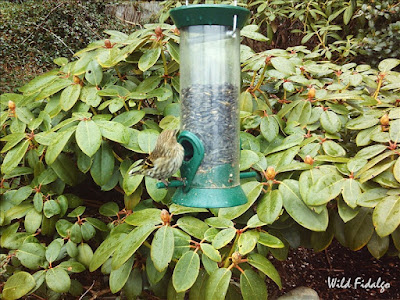After changing seed to black sunflower, another species has debuted at the BirdCam station. Here are the first images caught of a Pine Siskin ( Carduelis pinus ) since installing the camera last fall. These finches are said to be year-around residents in our area, but I see them only rarely. They resemble American Goldfinches in winter plumage, except they have a lot of brown streaking the Goldfinch lacks. The name " Carduelis " implies they are also fond of thistle seed ( carduus is a thistle). Later this spring, I'll be putting up a thistle feeder to what that will attract. According to BirdWeb , my yard provides their desired habitat, "semi-open areas, including forest edges and weedy fields." Well, let's hope not too weedy. They nest on horizontal branches of large conifers which I also furnish, so perhaps I'll have a nesting pair or two. The BirdCam station is currently in a fairly open area of the yard, and near the house. I ...






